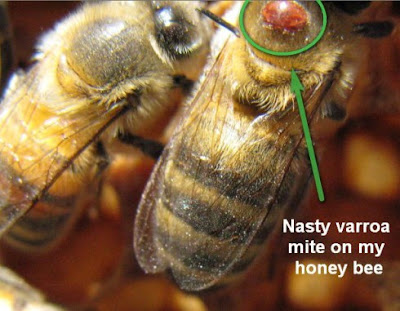In a
post from June 1, 2013, I discuss the
Varroa mite and its impact on bees. This evening (June 2, 2013), I collected the sticky boards that I placed under the hives on Friday, May 31, 2013. If you'd like to skip right to the
YouTube video, it is here.
Since the boards were placed at 1030 on 5/31/13 and retrieved at 1820 on 6/2/13, they were under the hives for 2 days, 7 hours, and 50 minutes. This is about 2.3 days. Most sites that describe how to count mites use the 24-hour drop number as the standard. So, the number of mites that I would count would need to be divided by 2.3 to give me my daily, 24-hour, drop rate.
You may recall that Hive A had a sticky board with Vaseline around the periphery only. My thinking was that the mites would eventually reach an edge in their effort to get back to the hive to re-attach to a bee. In their wandering, they would come to the Vaseline and stick. I think this was sound reasoning. However, as I was walking back to the house with the sticky board, I realized the potential problem. The wind may have gusted any mites not yet stuck to Vaseline right off the board. For the future, I will coat the whole board with Vaseline. Live and learn, I guess...
In the end, Hive A's sticky board had only one mite. Although the hive may just be quite low on mites and healthy, it could be that there were more that just blew off into the prairie. Hive B's sticky board (the one with Vaseline over the whole surface) had 6 mites. I attempted to take a photo of a mite. I think that I need a different lens for the camera. Below, you can see my attempt to take the picture with the camera's auto-focus looking through a magnifying glass with a light source coming in from the side. I probably confused the heck out of the camera.
 |
| Counting mites. |
 |
| Close-up view. Mite is the reddish-brown thing in center of magnifying glass field. |
There are many methods for counting mites and using that number to estimate the hive's "mite load." It seems that--by any of them--both Hive A and Hive B are currently in the clear. Here are two examples of how to decide whether to treat the mites or continue to monitor.
Using an absolute number of mites dropped per day:
Some methods simply use a total daily mite count to decide whether to treat the hive or not. Some sites recommend treating the hive for mites if the daily mite drop is 5 - 10 mites. Others say that you can wait until reaching 40 mites per day.
If I assume a worst-case scenario and say that each hive had 6 mites dropped in 2.3 days, that becomes a daily mite drop of about 2.6 mites. This seems to be well below the threshold number at which I would consider treatment.
However, the hive size is not taken into account. In one day, 20 mites falling off a small hive of only 10,000 bees is a lot different than 20 mites falling off a huge hive of 70,000 bees. My hives are currently small, so perhaps 2.6 mites per day is a problem...?
Using the drop rate and trying to estimate the number of bees to get mites dropped per bee per day:
I found a site that claims that a medium frame (which I am using) full of bees on both sides has 1,250 bees. If I look at my inspection checklist from the
May 29, 2013 inspection, I see that Hive A had four full frames of bees and two half-full frames of bees. Hive B had 4 full frames of bees and about three half-full frames of bees.
Bees in Hive A:
- (full frames x 1,250) + (half-full frames x 625)
- (4 x 1,250) + (2 x 625) = 6,250 bees*
Bees in Hive B:
- (4 x 1,250) + (3 x 625) = 6,875 bees*
Continuing with this method, the next advice is, "If your sticky board count shows more than 2 mites per thousand bees per day in mid-August or more than 4 mites per thousand bees per day in September, you should find a way to reduce the mite population." It doesn't say what to be worried about in June.
In any event, 2.6 mites per about 6,500 bees per day is less than one-half mite per thousand bees per day. I feel fine with not treating at this time. However, I will--probably tomorrow night--put the sticky boards back down to get another count.
* = These estimates make sense to me, and make me feel confident in the results. The packages of bees that I installed on May 4, 2013 each had about 7,000 bees in it. Allowing for some death of the older bees, but with the newly-born bees not yet replacing the population, having about 6,500 bees in each hive sounds about right. Recall that some may have been out foraging during the last inspection, too, so there may be more than 6,500 in each hive. But, again, it seems to be a very good estimate.


























